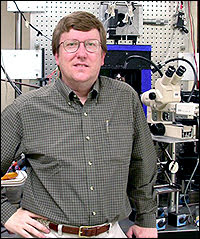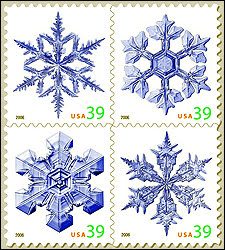Microphotographic images of snowflakes captured by California Institute of Technology physics professor Kenneth Libbrecht will appear on US postal stamps beginning this month. The set of four commemorative stamps are the result of Libbrecht's investigations into how patterns are created during crystal growth and other simple physical processes, in particular, a case study of snowflakes. His research is aimed at better understanding how structures arise in material systems, but it is also visually compelling and, from the start, has been a hit with the public: Libbrecht said his Web site, www.snowcrystals.com, is getting about two million hits a year. Libbrecht attributes the site's popularity to its discussion of very accessible science. 
A photo of a real snow crystal captured by Kenneth G. Libbrecht using a specially designed snowflake photomicroscope. (Photo: Kenneth G. Libbrecht)
"Snowflake patterns are well known, the snowflakes fall right out of the sky, and you don't necessarily need a science background to appreciate the science behind how these ice structures form," he said. "It's an especially good introduction to science for younger kids."
Libbrecht began his research by growing synthetic snowflakes in his lab, where they can be created and studied under well-controlled conditions. Over several years, Libbrecht developed some specialized techniques for capturing images of snow crystals. In 2001, he also began photographing natural snowflakes. Precision microphotography was necessary for this work.
"A few years ago, I mounted my microscope in a suitcase, so I now can take it out into the field," he said. "Sometimes I arrange trips to visit colleagues in the frozen north, and other times I arrange extended ski vacations with my family.
The most difficult part of his work nowadays, he said, is getting the complex-looking instrument through airport security. Libbrecht's camera rig is essentially a microscope with a camera attached. The entire apparatus was built on campus and designed specifically for snowflake photography.

Kenneth Libbrecht, a physics professor at the California Institute of Technology. (Photo: Kenneth G. Libbrecht)
"Snowflakes are made of ice, which is mostly completely clear, so lighting is an important consideration in this whole business," he said. "I use different types of colored lights shining through the crystals, so the ice structures act like complex lenses to refract the light in different ways. The better the lighting, the more interesting is the final photograph."The structures of snowflakes are ephemeral, so speed is of the essence in order to get good photographs. Within minutes after falling, a snowflake will begin to degrade as its sharper features evaporate away. The complex structures are created as the crystals grow, and when they stop growing, the crystals soon become rounded and more blocky in appearance.
"When photographing in the field, I first let the crystals fall onto a piece of cardboard," said Libbrecht. "Then I find one I like, pick it up using a small paintbrush and place it on a microscope slide. I then put it under the microscope, adjust the focus and lighting and take the shot. You need to search through a lot of snowflakes to find the most beautiful specimens."
Libbrecht said observing natural snowflakes in the field is an important part of his research and nicely complements his laboratory work.
"I've learned a great deal about crystal growth by studying ice and have gotten many insights from looking at natural crystals. Nature provides a wonderful variety of snow crystal types to look at, and the crystals that fall great distances are larger than what we can easily grow in the lab," he said. So where does one find really nice snowflakes? Libbrecht said some snowy places are better than others. The snowflakes chosen for the stamps were photographed in Fairbanks, Alaska, in the Upper Peninsula of Michigan, and in Libbrecht's favorite spot: Cochrane, in Northern Ontario. "Northern Ontario provides some really excellent specimens to photograph," said Libbrecht. "The temperature is cold, but not too cold, and the weather brings light snow frequently.
"Fairbanks sometimes offers some unusual crystal types, because it's so cold. Warmer climates, for example, in New York State and the vicinity, tend to produce less spectacular crystals." As for the nitty-gritty of snowflake research, probably the question Libbrecht is asked the most is whether the old story about no two snowflakes being exactly alike is really true. "The answer is basically yes, because there is such an incredibly large number of possible ways to make a complex snowflake," he said."In many cases, there are very clear differences between snow crystals, but of course there are many similar crystals as well. In the lab we often produce very simple, hexagonal crystals, and these all look very similar."

The commemorative Holiday Snowflake Stamps recently issued by the US postal service
Snowflakes generally take one of seven basic forms. For example, stellar, or starlike, snowflakes usually grow six primary branches that support arms, which often develop thin plates of ice at the ends. Bitter-cold conditions create crystals with more facets. The most symmetrical snowflakes occur during light snowfalls when there is cold weather and little wind. If the air is warmer, crystals tend to stick together to form less symmetrical snowflakes, or they can take on a needlelike shape. In higher humidity, snowflakes may branch more, making them dendritic, or plantlike, in appearance. The Holiday Snowflakes stamps are photographs of two basic snowflake patterns. They are stellar dendrites, which form branching treelike arms, and sectored plates, which as their name suggests, form platelike arms. Because fallen snowflakes start to melt and lose their shape in mere minutes, Libbrecht quickly transferred the snowflakes from cardboard to a glass slide using a paintbrush. He then snapped the photos inside a temperature-regulated enclosure.
Falling from thousands of feet, these intricate ice crystals commonly begin as a piece of dust tumbling through the clouds. Gathering water molecules, they blossom into crystal forms in endlessly different patterns because of the constantly changing conditions of the atmosphere.
Libbrecht can grow many different snowflake forms at will in his lab, but says there are still many subtle mysteries in crystal growth that are of interest to physicists who are trying to understand and control the formation of various materials. A real-world application of research on crystals is the growth of semiconductors for electronic gadgets. These semiconductors are made possible in part by painstakingly controlling how certain substances condense into solid structures.
When he's not studying snowflakes, Libbrech is also involved in the Laser Interferometer Gravitational-Wave Observatory (LIGO), an NSF-funded project that seeks to confirm the existence of gravitational waves from exotic cosmic sources such as colliding black holes.
In LIGO, Libbrecht has a lot of professional company; in fact, the field was essentially founded by Albert Einstein, who first predicted the existence of gravitational waves as a consequence of general relativity. Kip Thorne and Ron Drever at Caltech, along with Rai Weiss at MIT, were instrumental in initiating the LIGO project in the 1980s.
But in snowflake research, Libbrecht is pretty much a one-man show. He said something about the exclusivity appeals to him.
"It suits some of my hermit-like tendencies," Libbrecht said. "As Daniel Boone once said, if you can smell the smoke of another person's fire, then it's time to move on. My research on snow crystal growth is the one thing I do that simply wouldn't get done otherwise."
For more information about the Holiday Snowflakes collection, visit: www.usps.com/communications/news/stamps/2005/sr05_054.htm